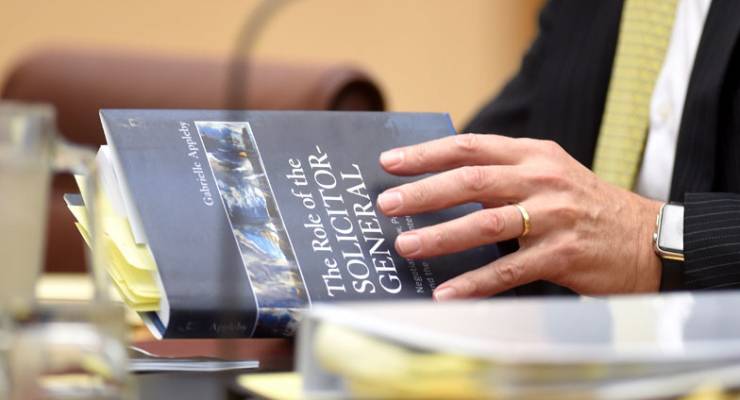
There is a bit of a spat going on between Attorney-General George Brandis and Solicitor-General Justin Gleeson, with Brandis having issued a direction (or an order) that all requests for Gleeson’s legal advice had to go through Brandis’ office. Brandis said it was all above board, and that Gleeson had given the green light to the direction. Gleeson countered that he most certainly had not, and it seems Brandis might have told a few porky pies to Parliament about the matter — Gleeson was not, in fact, consulted.
But just what is the Solicitor-General, anyway? And what is his relationship to the Attorney-General? People have written PhD theses on the history of the convoluted relationship between the nation’s first and second law officers.
Canada has even abolished the Solicitor-General position altogether.
Just to confuse everyone further there’s also an Australian Government Solicitor. But herewith, a quick guide to the Solicitor-General.
What the hell is a Solicitor-General?
The Solicitor-General, or SG, acts as legal counsel for the Commonwealth government as per The Law Officers Act s12.
After the Attorney General (AG), the SG is the second most important legal officer of the Commonwealth.
He is appointed by the Governor-General for an indefinite amount of time. The Solicitor-General is not a member of Parliament.
The SG typically advises the Commonwealth on matters of international and constitutional law.
Why have a Solicitor-General?
This question is key in the current debate.
The SG provides advice independent of the AG, as part of two-tiered system designed to ensure checks and balances.
This of course runs in conjunction with concept of “separation of powers”, which states that legislative power must be split between the Parliament, executive and judiciary.
The AG is an elected member of Parliament and belongs to a political party. Thee SG is more of a public service figure free from political influence.
What is the relationship between the Solicitor-General and the Attorney-General?
The SG falls under the administration of the Attorney-General’s Department, although he doesn’t necessarily have to agree with him.
Ultimately the AG has the final authority. But Gleeson does not think Brandis should be able to run roughshod over his advice.
Senior fellow at Bond University law school Christopher Goff-Gray has written extensively on the subject and still finds their relationship murky. He said in a 2011 article, “The Solicitor-General in context: A Trijurisdictional Study“ it was not clear whether the Solicitor-General should be an advocate for the government or should be a non-partisan adviser.
Is the SG actually non-partisan?
Not according to George Brandis.
In his 2011 article, Goff-Gray pointed out that the issue had not been sufficiently addressed in Australia. Hence the current debacle.
“Can a Solicitor-General be a ‘neutral advocate’ or is this merely a contradiction in terms?” he wrote.
Critics and academics over the past week have expressed concern that Brandis has overstepped the mark by stating the Solicitor-General can only be consulted upon his request.
American constitutional scholar Louis Fisher, who is quoted in Goff-Gray’s 2011 article, believes there are two separate important legal guys for a reason.
“The adversary system depends on opposing attorneys who present as vigorously as they can their conflicting positions in court,” Fisher is quoted in the article as saying.
And what about the Australian Government Solicitor (AGS)?
The current Government Solicitor is Louise Vardanega. She oversees a team of lawyers, the Australian Government Solicitors, who provide legal advice to government authorities. The AGS is not a central figure on matters of constitutional significance. AGS was brought under the Attorney-General’s Department last year, but its website is at pains to point out: “It continues to operate as the pre-eminent provider of legal services to the Australian Government and its agencies and will have its own independent functional identity within the Department.”








Brandis is a walking catastrophe, pompous and grossly incompetent, deceitful, abusive and evasive…but with these skills he is a very good fit in the LNP team.
I expect Turnbull will continue to support him because their moral compasses are so similar.
Further to your free character (sic!) of Brandarse, I would just add that he is perfect example of a stupid person unaware of how dumb he really is.
Should the AGS have been brought under the AG’s dept, no fanfare or scrutiny? Seems to me like another Brandis power grab.
Let’s hear it for separation of powers in government, aka checks & balances, to guard us against a repeat of the Rodent’s reign of error post 2004 when he had control of both Chambers.